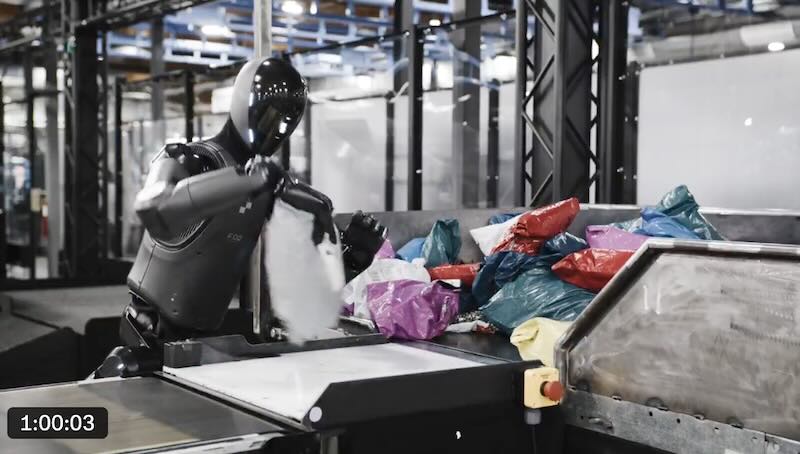Figure has released an extensive video showcasing its Figure 02 humanoid robot tackling a challenging package sorting task for an entire hour. Demonstration reveals the robot’s ability to handle various parcel types—cardboard boxes, plastic bags, and document envelopes—while organizing them with specific positioning requirements for barcode scanning.
The Figure 02 humanoid robot performance video represents a significant milestone in robotic logistics automation. Robot systematically processes mixed packages, rotating each item to position barcodes downward and flattening materials for optimal scanning conditions. While the hour-long demonstration includes occasional hiccups, such as a 20-second struggle with a crumpled package around the 27-minute mark, the overall execution demonstrates substantial progress in autonomous sorting capabilities.
Figure has been deploying its Helix robot model in logistics environments for three months, generating measurable improvements in both speed and accuracy metrics. The company’s approach combines extended training datasets with architectural enhancements to achieve these performance gains.
The Figure 02 humanoid robot now processes different package types by dynamically adjusting its grip and sorting strategy based on material properties and shape characteristics. Adaptive behavior allows the system to handle cardboard boxes, soft plastic bags, and document envelopes within the same workflow.
Despite increasing task complexity, the robot’s average handling time per package has improved from 5 seconds to 4.05 seconds, representing a 20% speed increase. Performance improvement occurred while maintaining high accuracy standards across diverse package types.
The humanoid robot’s barcode scanning success rate for downward-facing codes has increased from 70% to approximately 95%. Improvement stems from the model’s self-taught ability to smooth and flatten packages—a behavior learned through observation of human sorting techniques rather than explicit programming.
Figure 02 humanoid robot acquired this package flattening capability by analyzing video footage of human workers performing similar tasks. Learning approach demonstrates the system’s ability to develop new behaviors through observation rather than traditional programming methods.
Figure has enhanced the Helix model with a temporal memory module and force-feedback sensing capabilities. Also expanded the training dataset from 10 hours to 60 hours, significantly boosting overall performance metrics.
The expanded dataset contributed to improved average handling time, dropping from 6.34 seconds to 4.31 seconds, while accuracy climbed from 88.2% to 94.4%. Improvements reflect the value of comprehensive training data in robotic learning systems.
The temporal memory module provides the model with extended contextual understanding of sorting tasks, moving beyond reliance on instantaneous camera frames. Force-feedback input enables more precise gripping and manipulation of packages with varying weights and textures.
These architectural upgrades have pushed average handling time down to 4.05 seconds, with accuracy settling at approximately 92.5%. Interestingly, this represents a slight accuracy decrease despite the technical improvements, suggesting potential trade-offs between speed and precision.
Figure 02 humanoid robot demonstrates natural human-robot handoff capabilities, visually recognizing when workers extend their hands as handoff signals. Behavior requires no explicit programming, as the model learned to identify and respond to human gestures through observational learning.
Robot successfully transfers packages directly to human workers upon recognizing handoff cues, enabling seamless integration into existing warehouse workflows. Collaborative capability positions the Figure 02 robot as a practical solution for mixed human-robot work environments.
Figure’s demonstration proves that robotic package sorting has truly figured out how to handle the complex demands of modern logistics operations.
Related Post
Can Robots Be Mass-Produced Like Phones? Figure’s CEO Brett Adcock Weighs In
BMW Robotic Revolution: Figure 001 Humanoid Shifts Gears in Automotive Manufacturing
Tesla Optimus Robot Masters Complex Tasks Through Revolutionary Video Learning
